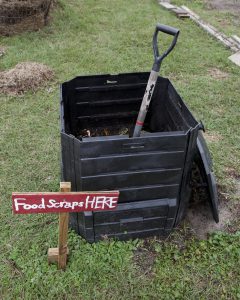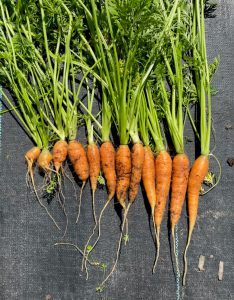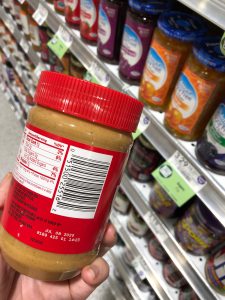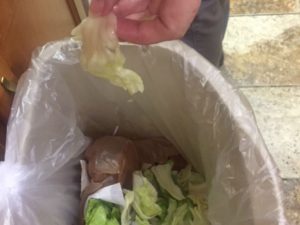
by Samantha Kennedy | May 13, 2021
I would like to continue on the theme of reducing food waste by talking more specifically about ways to use food scraps effectively to prevent them from ending up in the landfill.
As I was thinking about this topic, I was reminded of a funny scene from the 1982 film Night Shift, where Michael Keaton’s character, Billy Blaze, says into his tape recorder, “Idea to eliminate garbage: edible paper. You see, you eat it, it’s gone. Eat it, it’s out of there. No garbage.” Think about how much less waste would go into our landfills if we could just eat paper!
It is the same concept for food waste. As much as 40% of food grown, processed, and transported in the United States will never be eaten, destined to end up in the landfill. That is literally thousands of tons of food wasted each year. But what if we could help reduce that amount?

Got leftover veggie scraps? Instead of throwing them away, save them for a delicious veggie soup.
(Photo source: UF/IFAS)
Here are two great ideas for using leftover food scraps instead of throwing them away.
Cook with them. Leftover vegetables are great ingredients for a simple and delicious soup. Simply take the leftovers, combine them with an aromatic base of onions, garlic, and celery, add a liquid such as stock or broth (or water and white wine), throw in a generous helping of herbs, and cook for about 25-30 minutes. Then use an immersion blender or food processor (or stand-up blender) to blend into a creamy soup. Any type of vegetable works for this type of soup, from greens and cauliflower to parsnips and sweet potatoes, which makes it an ideal way to use up those scraps.
Another great way to use vegetable scraps is to make homemade stock. Vegetable parts such as carrot ends and peels, celery ends and greens, corn cobs, pea pods, and all the other bits trimmed off during food preparation can be used to make stock. Not in the mood to make stock right away? No problem! Veggie scraps can be saved in a zippered bag and kept frozen for up to six months.
When the time comes, simply dump the scraps into a large stock pot (that is why it is called a stock pot!) or Dutch oven, fill the pot 3/4 of the way with water, bring to a boil and simmer for at least 30 minutes. (The longer it simmers, the richer the flavor.) Strain it all through a sieve. The remaining liquid is the stock. Fresh stock can be stored 3-5 days in the refrigerator or frozen up to three months. Here is a simple resource from Cornell University Extension on how to make vegetable stock from kitchen scraps. (Here is another one from Tasty.co.)
Hold on! There are still scraps left over. What about those? Well, that brings me to the second great way to use kitchen scraps.

Food waste such as vegetable scraps can be added to compost to create a nutrient-rich fertilizer for home gardens.
(Photo source: Tyler Jones, UF/IFAS)
Compost them. Creating compost at home takes a little work and perseverance, but it can certainly pay off in the home garden. Nutrient-rich compost can add oomph to flower beds and vegetable patches and turn any garden into a showcase.
Vegetable scraps are perfect additions to any compost pile. Any vegetable scraps can be added to compost. Just remember to remove the little stickers, as those are not compostable.
According to the Environmental Protection Agency (EPA), there are many benefits to compost. It enriches soil, helping retain moisture and suppress plant diseases and pests. It reduces the need for chemical fertilizers. And it encourages the production of beneficial bacteria and fungi that break down organic matter to create humus, a rich nutrient-filled material. These fact sheets (this one and this one) from UF/IFAS Extension are a wealth of information about home composting.
The reduction of unnecessary food waste begins with us, the consumers. By learning how to use those scraps in useful ways, such as cooking and composting, we can help eliminate the excess food waste filling our landfills.
UF/IFAS is an Equal Opportunity Institution.

by Heidi Copeland | Apr 7, 2021

Carrots
Photo source: Heidi Copeland
According to industry standards, some of these carrots could not be sold because of “Serious damage” or any defect which seriously affects the general appearance of the
carrots in the container.
Waste less, save money is a great creed to live by. Really, it is that simple. One excellent example of this is food. Research indicates that 40% of all food in America is wasted yet, one in eight Americans does not have enough access to affordable, nutritious food. In other words, they are “food insecure.”
Wasted food is a MASSIVE problem at the commercial, institutional and residential levels. In fact, the Environmental Protection Agency (EPA) estimates there is more food than any other single material in our everyday trash and that approximately one-third of all food produced for human consumption worldwide is lost or wasted. In fact, in 2015, the USDA joined with the U.S. Environmental Protection Agency to set a goal to cut our nation’s food waste by 50 percent by the year 2030.
The sad fact is, most people do not realize how much impact food and food waste has on the earth and its issues of sustainability. Food waste occurs at every level of involvement. Examples of food waste include growing, processing (by-products too), transporting, point of sale, plate waste and uneaten prepared foods, and kitchen trimmings and their eventual disposal. Preventing food waste at all these levels can make a difference in addressing this issue.
However, preventing food waste it is not as easy as it seems. Many consumer factors also contribute to the problem.
- Food date labels confuse people. Use by/sell by dates are not always about food safety but about peak quality. Many foods are still safe to eat after their dates. Inspect “expired” foods closely via sight and smell before consuming – find ways to use up food past its prime.
- Households overbuy – do you really need super sizes? Buying in bulk is not always less expensive if much of it is discarded. Only purchase what you know you will use and do not get lured in by the “more for less” deals.
- Massive portions are often served – share or learn to love leftovers. Split enormous portions into multiple meals.
- Grocery stores overstock their shelves to maintain an image of abundance.
- People demand “perfect” produce. Farmers have a hard time selling less than stellar items. “Ugly” fruits and vegetables are just as delicious and nutritious as their more photogenic counterparts. Places such as farmers’ markets and community gardens are good places to find imperfect produce that would otherwise go to waste.
This Earth Day, (an event first celebrated on April 22, 1970 in the United States and is now a globally coordinated event in more than 193 countries) commit yourself to taking an action. As the late Neil Armstrong famously quoted as he stepped on to the moon… “This is one small step for a man, one giant leap for mankind!” If each of us considered and implemented our own practical or creative approaches to preventing food from going to waste what would our collective actions mean for mankind?

Fresh Carrots
Photo Source: Heidi Copeland
The best way to reduce food loss at home is not to create it in the first place. Not only would we individually save money, our collective efforts could conserve resources for future generations. The best method is the one you use.
- Reduce wasted food – shop smart, plan what you purchase, and use it, ALL of it!
- Maximize the efficiency of your refrigerator based on science. Read your refrigerator manual to learn where the coldest spots in the refrigerator are and what foods benefit from refrigerator location.
- Maximize the efficacy of canned products… use the FIFO (first in first out) method of rotation to use the oldest product before the newest on the shelf.
- Donate what you cannot use to others.
- Divert food scraps to animal food (chickens anyone?)
- Compost
- Landfill as the last resort.
Common causes of personal food waste include overbuying, over preparing and spoilage. The basic tenets of sustainability – reduce, reuse, recycle and refuse, work to reduce food waste too! Pay attention to purchases, eat what is prepared, store food properly, and refuse to waste. We can all do our part! Let’s start today.
https://savethefood.com/recipes/

by Amy Mullins, PhD, RDN | Aug 24, 2018

Photo source: UF/IFAS Northwest District
If your family is like most, grocery shopping is a dreaded weekly task. Typical shoppers usually have an idea of what they plan to purchase based on a previously made shopping list. Even then, it’s easy to go astray with impulse purchasing, bargain prices, and buy-one-get-one free opportunities that simply can’t be passed up! Before you know it, the shopping cart is loaded with delicious treasures just begging to come home with you.
Now that you have done the shopping, transported it home, and begun to put food items in their appropriate storage places, you realize the refrigerator, freezer, and pantry are cramped and nearly full. On a related aside, you should see my parents’ pantry. They have enough cans, boxes, and packages to feed their entire neighborhood…twice! Not to mention the two full size refrigerator/freezers that are bursting at the seams. Like my parents, I suspect many of us have a food overbuying addiction. So what happens next? Well, it’s time to clear out the old and make way for the new, of course. But how do you know what to purge and what is still good to keep?
Food Date Labeling Confusion and Food Waste
Standard or uniform language for food product dating does not exist in the U.S., which makes things tricky when it comes to deciphering expiration dates. Current Federal regulations do not require product dating (excluding infant formula), but instead allow food manufacturers to voluntarily set and display these dates on product packaging. With the lack of Federal measures, product dating enforcement is left up to individual states, resulting in consumer confusion over food safety. The U.S. wastes close to an estimated 40% of food produced annually, which equals approximately 160 billion pounds (Harvard Food Law and Policy Clinic). Of that, confusion over the meaning of date labels seems to be responsible for roughly 20% of safe and edible food wasted by consumers. Undoubtedly, this hurts purchaser’s pocketbooks and results in $29,000,000,000 of wasted consumer spending yearly (Food Date Labeling Act of 2016, 114th Congress 2D Session).
Food Quality vs. Food Safety
While cleaning out the pantry and cold storage, I also have been guilty of trashing perfectly good food. So many of us unknowingly accept the stamped date as common law not to be questioned. So what does that date actually mean?
The “open” date used by the manufacturer or retailer on food packaging is passively thought of by the consumer as the “expiration date,” or the last date a food can safely be eaten. This is a very common misconception. Food safety is not represented by this date, but rather it refers to product quality and freshness. Dates determined by food companies take into consideration such factors as ingredients, product characteristics and packaging, as well as time and temperatures associated with distribution, retail sale, and storage.
With no current standards in place, a variety of food date phrases are utilized which often are misleading to retailers and consumers. Most commonly used phrases include:
- “Best If Used By/Before” indicates when a product will be of best flavor or quality.
- “Sell-By” indicates to the retailer when the product should no longer be displayed for sale.
- “Use-By” is the last date recommended for use of the product at peak quality. This is only a safety date when used on infant formula packaging.
It’s important to remember that open dates on food products ONLY reflect food quality and NOT food safety (except for infant formula). For a list of specific foods and recommended storage time frames, check out the FoodKeeper resource at FoodSafety.gov.
Food Spoilage
Knowing the signs of spoilage will help you determine if a food is no longer fit for consumption. Although the quality date may have passed, the food is safe until it begins to spoil. Spoiled food may have a different smell, taste, and/or texture with sometimes visible discoloration. This occurs when environmental conditions (such as temperature, moisture, and oxygen) are introduced which support the growth of bacteria, molds, or yeasts. Given enough time, these microorganisms multiply rapidly and affect the safety of the food. If perishable items are not handled and stored properly, spoilage occurs much more rapidly. Learn more about proper refrigeration and food safety.
Do Your Part at Home
- Plan meals in advance and make a specific grocery list. Check the refrigerator, freezer, and pantry to utilize what you already have on hand.
- Don’t overbuy! Especially be aware not to purchase excess perishable items that are likely to spoil quickly. These may be foods that require cold storage, fresh bakery items, and fresh produce.
- Always look for and compare date labels of an item; choose the one with a later date.
- Store foods promptly and properly for food safety and best quality. Discard potentially hazardous cold food items that have not been properly refrigerated for 2 hours or more.
- Keep a thermometer inside the front of your refrigerator and check it regularly to be sure it stays below 40 degrees F.
- Thaw foods safely! Thawing in the refrigerator is the safest way, but using cold running water or defrosting in the microwave are acceptable ways to speed up the process. Never sit foods out at room temperature to thaw!
- Recognize the signs of food spoilage and promptly discard foods that smell funny, have off-flavors, obvious mold growth, or sticky or slimy textures (such as fish, poultry, and deli meats).
- Evaluate each item in your pantry and consider whether or not it’s something you want to continue to store and use or want to remove.
- High temperatures affect the shelf life of shelf-stable foods so it’s important to store dry goods and pantry items in temperatures at or below 85 degrees F. Use the “First In First Out” (FIFO) method of rotation, using older items before newly purchased ones. Read more about Shelf Stable Food Safety.
- Discard cans that are rusty, bulging, or leaking, as they are at a high risk for containing the deadly pathogen that causes Botulism. Never taste suspicious foods! Take extra caution by disposing of cans and jars into a tightly closed plastic bag before placing in an outside trash receptacle.
Help Families in Need & Keep Unused Wholesome Food Out of Landfills
Mistakenly discarded food products, not only is the U.S. but globally, have created a sad cascade of wasted resources and money with increasingly negative environmental and social implications. Food banks and local community organizations have plenty of under-served and needy families who can benefit! Remember, it’s safe to donate dry and canned goods, perishables, and other food related items that are beyond the quality date of the product.
Find a food bank near you.
We all can do our part to reduce the amount of wasted food, save money, help the environment, and help our communities!
Additional Resources:
https://www.usda.gov/oce/foodwaste/sources.htm
https://www.usda.gov/oce/foodwaste/resources/donations.htm
USDA Food Safety Information, Food Product Dating
USDA Food Labeling Fact Sheets

by Kendra Hughson | Apr 10, 2018

Save money and the environment by reducing the amount of food thrown in the trash. Credit: Kendra Zamojski
A hot topic in kitchens and restaurants these days is food waste. Chefs, restaurant managers, and even consumers are looking for ways to save money and the environment by reducing the amount of food tossed in the trash.
The United States Department of Agriculture estimates about 31% of food is lost at the retail and consumer level. Much of this food loss ends up in the landfill. The USDA is challenging consumers to reduce, recover and recycle their food waste.
The Basic Level:
If you know your family is tossing a lot of food in the trash and you want some easy ways to reduce the waste, try these:
- Plan your meals using foods you already have on hand and choosing foods you know you will use before they go bad. Substitute ingredients to include food you already have in the pantry or refrigerator.
- Create grocery lists using your family meal plan and checking for foods you already have on hand.
- Plan to use or freeze leftovers for dinners or lunches throughout the week.
- Watch what is being tossed and reduce your purchase of these items.
The Intermediate Level:
If your family is already good at the basic level and you want to take food waste reduction to the next level, try these steps:
- Make food purchases with packaging in mind. Choose items with minimal packaging.
- Store foods properly, with food safety in mind. Use food storage guides to properly store food items safely.
- Freeze what you can’t use in time. Follow these guides for freezing vegetables and freezing prepared foods:
- Use edible parts that you don’t usually eat when it’s safe. For example, save broccoli stalks and stems or potato peels for use in soups and casseroles.
Food Recovery Level:
If your family is ready to divert food from the landfill, try these steps:
- Compost your food waste. Contact your local Extension office for more information. Check out this resource on composting.
- Donate unused, unspoiled food.
Next time you throw food in the trash, take a minute to think about taking the challenge to reduce food waste. A few easy steps can help save your family money and the environment for future generations to enjoy.
Kendra Zamojski is a Regional Specialized Agent in Family and Consumer Sciences with the University of Florida/IFAS Extension. For more information, contact Kendra at hughson@ufl.edu.
by Heidi Copeland | Apr 17, 2013

Two-thirds of American household waste is due to food spoilage
Sustainability – 1. The ability to be sustained, supported, upheld, or confirmed. 2. Environmental Science: The quality of not being harmful to the environment or depleting it.
This Earth Day, think about the dictionary definitions of sustainability, especially as they relate to consumer choices. Take food, for instance. As a nation, not only are we becoming super-sized but so is our food-related waste. In August 2012, the Natural Resources Defense Council (NRDC) reported that Americans are throwing away 40 percent of their food supply in the U.S. every year. The reasons for this problem are multifaceted. Nevertheless, consumers are a major contributor to the problem. Key findings include:
- The average American family of four ends up throwing away an equivalent of up to $2,275 annually in food (I’ve started to tally up my own family waste and believe me, it adds up! Leftovers not eaten in time, half a can of evaporated milk, brown lettuce, wilted carrots, yellowing broccoli, etc…)
- In average American households, two-thirds of household waste is due to food spoilage
- 40 percent of fresh fish
- 23 percent of eggs
- 20 percent of milk
- Citrus fruits and cherries top the list for fruits, and sweet potatoes, onions, and greens are commonly wasted vegetables
- Much of household waste is due to over purchasing, food spoilage, and plate waste.
- One-third is caused by people cooking or serving too much (Package size, serving size, and dishware size all influence how much each of us eats).
Wasted food also translates into wasted natural resources because of the energy, water, and farmland necessary to grow, transport, and store food. Additionally, food waste is the single largest component of solid waste in U.S. landfills.
Every one of us can be a facet in solving this increasing problem. Each person can waste less food by:
- shopping wisely
- knowing when/how food goes bad
- eating produce that is perfectly edible even if it’s less cosmetically attractive (much of this is thrown out)
- cooking only the amount of food you can reasonably eat
- eating leftovers (consider them a bonus for lunch tomorrow)
Norman Vincent Peale says, Change your thoughts and you change your world. Can the same thinking apply to our behavior? If each and every one of us made a small behavior change, it could help change the world.
For more information: http://www.nrdc.org/food/wasted-food.asp
http://www.nrdc.org/living/eatingwell/saving-leftovers-saves-money-resources.asp











